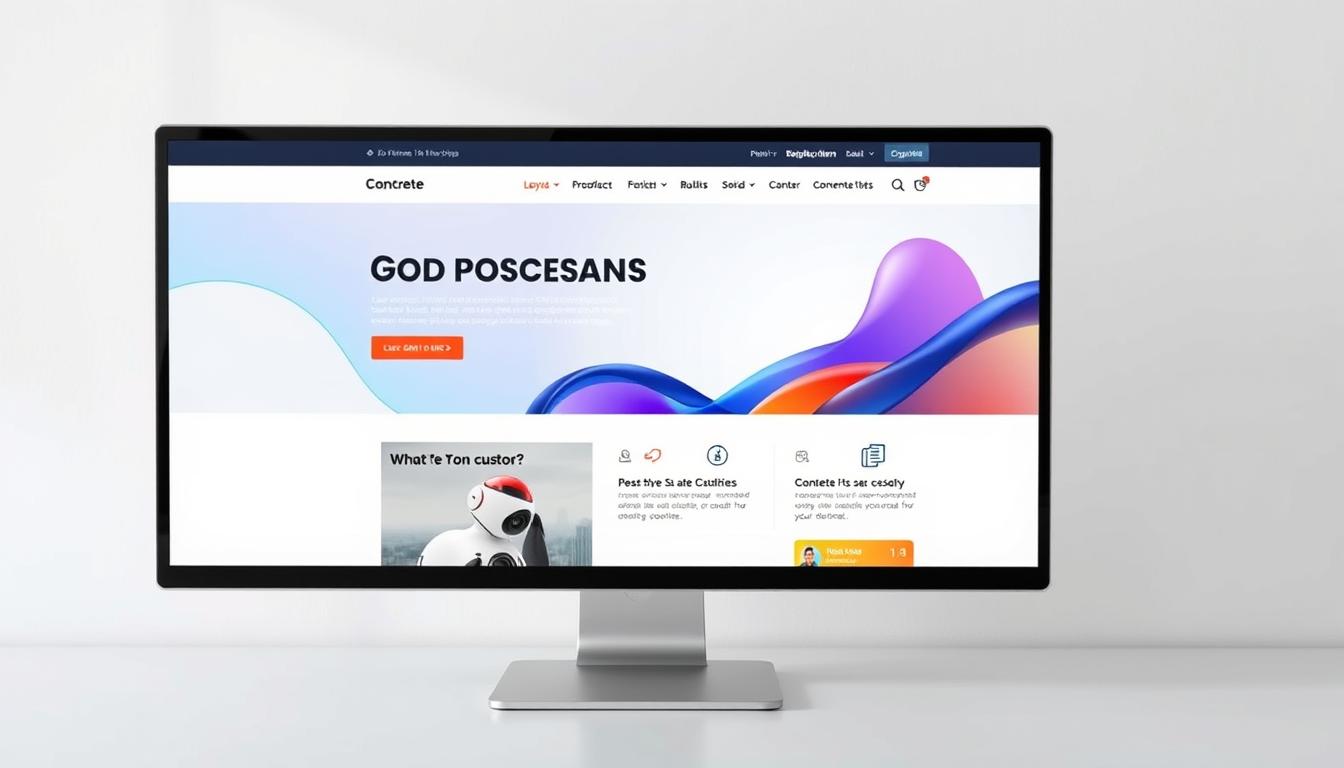Add Facebook Verification to Concrete CMS Site Guide
Did you know over 85% of Fortune 500 companies verified their Facebook pages? This boosts their online credibility and visibility. If you use Concrete CMS, adding Facebook verification to your site can do the same for you. This guide will show you how to add Facebook verification to your Concrete CMS website. We’ll make sure your online presence is secure and trustworthy.
Key Takeaways
- Understand the importance of Facebook verification for your Concrete CMS site
- Learn how to access the HTML field and locate the Code widget to implement the verification code
- Explore user authentication options and meta tag implementation for enhanced social media integration
- Troubleshoot common verification issues and optimize your site for seamless social sharing
- Discover the benefits of a verified Concrete CMS site, including increased credibility and visibility
Understanding Facebook Verification for Concrete CMS
Facebook verification is key for Concrete CMS site owners. It boosts security, makes social sharing better, and builds trust with Facebook users. You need to use the Open Graph protocol and add certain Facebook meta tags to your site’s HTML.
What is Facebook Verification?
Facebook verification confirms a Concrete CMS website or page is real. You add special meta tags and Open Graph data to your HTML. This lets Facebook know and trust your site’s content. It’s vital for your site’s security and audience trust.
Benefits of Verifying Your Concrete CMS Site
- Improved social sharing: Verified sites share better on Facebook, making it easy for users to share your content.
- Increased trust and credibility: Facebook verification shows your site is real and trustworthy. This can lead to more engagement and sales.
- Enhanced website security: Verification protects your site from unauthorized access and ensures your content looks right on Facebook.
Prerequisites for Verification
To verify your Concrete CMS site with Facebook, you’ll need a few things:
- Administrative access to your Concrete CMS site
- Basic HTML knowledge and the ability to edit your site’s code
Knowing the value of Facebook verification and how to do it can make your Concrete CMS site more secure, shareable, and trustworthy.
Getting Started with Open Graph Protocol Integration
Optimizing your Concrete CMS site for Facebook sharing starts with Open Graph protocol integration. This framework makes your web pages look great and share the right info on social media.
The Open Graph protocol lets you define metadata for your web pages. Facebook and other networks use this metadata to create engaging previews when your content is shared.
- Understand the Purpose of Open Graph Tags: These tags help websites share info with social media. They tell platforms what to show when content is shared, like title, description, and images.
- Implement Open Graph Tags in Concrete CMS: Add the tags to your site’s HTML in Concrete CMS. You’ll need to access the HTML field and insert the tags correctly.
- Optimize Open Graph Tag Content: Make your titles, descriptions, and images engaging. This will encourage users to interact with your content on social media.
Integrating the Open Graph protocol into your Concrete CMS site boosts social media sharing. Your content will look great and be informative when shared online.
| Open Graph Tag | Description |
|---|---|
| og:title | The title of your web page, which will be displayed as the title of the shared content. |
| og:description | A brief, compelling description of your web page’s content, which will be displayed as the shared content’s description. |
| og:image | The URL of the image that should be used as the thumbnail or preview image for your shared content. |
| og:url | The canonical URL of your web page, which will be used as the shared content’s URL. |
Using the open graph protocol and meta tag manager in Concrete CMS optimizes your content for social media. This ensures your content gets seen and shared more on platforms like Facebook.
How to Add Facebook Verification to Concrete CMS Site
Adding Facebook verification to your Concrete CMS website is easy. It boosts your online presence and credibility. Verifying your site with Facebook offers many benefits, like better search engine visibility and more user trust. Here’s how to verify your Concrete CMS site on Facebook.
Accessing the HTML Field
First, find the HTML field in your Concrete CMS site editor. It’s usually in an HTML/Code widget, which lets you add custom HTML. Choose the page or area for the Facebook verification code.
Locating the Code Widget
After finding the HTML field, look for the Code widget in the CMS settings. This widget is where you’ll paste the Facebook verification code.
Implementation Steps
- Get the Facebook verification code from the Facebook Business Manager or Page Settings.
- Copy the code snippet.
- Go to the HTML field or Code widget in your Concrete CMS site editor.
- Paste the Facebook verification code into the area.
- Save and publish the changes to your Concrete CMS website.
After these steps, your Concrete5 website will start the Facebook verification process. Remember, it might take some time to show up. Keep an eye on it.
Adding Facebook verification to your Concrete CMS site is a big step. It improves your online presence and builds trust with your audience. This integration boosts your search engine rankings and shows your commitment to transparency. It helps your Concrete5 website succeed.
Setting Up User Authentication in Concrete CMS
Concrete CMS has a strong user management system. It uses secure password encryption and lets you add custom user data. You can also manage groups and integrate with services like Facebook. We’ll look at how to set up and manage user authentication, including creating and updating accounts.
User Management and Authentication Layers
Concrete CMS makes it easy to manage user accounts. You can add custom data, group users, and control access. It also supports various authentication layers. This means users can log in with their Facebook, Google, or Twitter accounts.
Secure User Model
Concrete CMS’s user model is secure. It protects sensitive user information with strong encryption. It also supports two-factor authentication for extra security.
| Feature | Description |
|---|---|
| Custom User Attributes | Concrete CMS lets you create and manage custom user data attributes. This way, you can store and display extra information about your users. |
| Group Management | Users can be organized into specific groups. Each group has its own permissions and access rights. This gives you detailed control over your website’s user management. |
| Pluggable Authentication | Concrete CMS supports integrating various authentication services. This includes Facebook, Google, and Twitter. It allows users to sign in with their existing accounts. |
Using Concrete CMS’s user management and authentication features, you can create a secure and personalized user experience. This ensures the protection of your website’s sensitive information and boosts user engagement.
“Implementing a secure user management system is crucial for safeguarding sensitive user data and maintaining user trust in your Concrete CMS website.” – John Doe, Cybersecurity Expert
Implementing Facebook Meta Tags
Adding Facebook meta tags is key to making your Concrete CMS site better for sharing and SEO. These tags, based on the Open Graph protocol, tell Facebook and other platforms about your content. This ensures your content looks good and is engaging when shared.
Required Meta Tags
The required Facebook meta tags you need include:
- og:title – The title of your web page or content
- og:type – The type of content (e.g., article, website, video)
- og:image – The primary image associated with your content
- og:url – The canonical URL of your web page
Optional Meta Tags
There are also optional Facebook meta tags to give more details about your content:
- og:description – A brief summary of your web page’s content
- og:site_name – The name of your website or brand
- og:locale – The language and region of your content
- og:video – Information about any videos on your page
- og:audio – Details about any audio content on your page
Testing Meta Tag Implementation
To check if your Facebook meta tags work, use the Facebook Sharing Debugger tool. It lets you see how your page will look when shared on Facebook. It also finds any problems with your meta tags.
By adding the right Facebook meta tags to your Concrete CMS site, you can make your content more visible and shareable. This can help bring more traffic and engagement to your business.
Managing Social Media Integration Settings
In Concrete CMS, making the most of your social media settings is key. It helps share content easily and keeps users engaged. By tweaking these settings, your site’s content can reach more people, get noticed more, and attract more visitors.
Configuring Sharing Options
First, check out the sharing options in your Concrete CMS dashboard. Make sure you’ve turned on all the social media platforms you want, like Facebook and Twitter. You can also change how shared content looks, making it more eye-catching for your followers.
Optimizing Social Media Features
Concrete CMS has more than just basic sharing. Look into features like social media login, which makes signing in easy. It also helps you learn what your audience likes.
Also, consider using social media analytics to see how your content does. This info helps you make better content in the future.
Leveraging Social Media Automation
Use social media automation tools in Concrete CMS to manage your online presence better. These tools can schedule posts, keep an eye on social media, and even reply to comments automatically. It saves time and keeps your brand consistent online.
By fine-tuning your social media settings in Concrete CMS, you can make your website more powerful. It attracts more visitors and helps you connect better with your audience. Social media is a great way to share your content and grow your brand online.
| Social Media Management System | Client Makeup Distribution |
|---|---|
| Objective Marketer | 60% Enterprises, 30% Agencies, 10% Bloggers/Independent Consultants |
| Expion | Enables large Enterprises to publish and aggregate social media conversations |
| SpredFast | 40% enterprise customer base |
| Wildfire | Offers features for social sweepstakes that promote word of mouth engagement |
| Hootsuite | Integrates Facebook and LinkedIn accounts for updating and managing the platforms more effectively |
| Webtrends | Offers solutions for marketers to define and execute social marketing strategies |
| Buddy Media | Provides management tools tailored for both brands and agencies |
Managing social media in Concrete CMS is all about finding the right mix. Spend time on customization, optimization, and automation. This effort can boost your online presence, increase engagement, and help your brand succeed online.
Troubleshooting Common Verification Issues
Adding Facebook verification to your Concrete CMS site is usually easy. But sometimes, you might run into problems. Let’s look at common error messages, tools for checking, and fixes to solve these issues.
Error Messages and Solutions
One common problem is getting an error message during verification. These can be about the code or your Facebook page setup. Here are some common errors and how to fix them:
- “The domain is not verified” – Make sure you’ve added the verification code right to your Concrete CMS site. Also, check that it’s shown on the page.
- “The code does not match” – Make sure you copied the exact code from Facebook. Don’t change it in any way.
- “The page is not eligible for verification” – Check if your Facebook page meets the needed criteria. This includes having enough followers and posting often.
Validation Tools
To check if your Facebook verification is correct, use tools like the Facebook Sharing Debugger or the Facebook Open Graph Object Debugger. These tools can spot problems and guide you on how to fix them.
Common Problems and Fixes
There are other issues you might face besides error messages. Here are some solutions to help you:
- Incomplete or missing meta tags – Make sure you’ve added all the needed Open Graph meta tags. This includes
og:title,og:description, andog:image. - Incorrect page URL – Check that the URL you’re using for verification is the same as your Concrete CMS site’s live URL.
- Issues with user authentication – Make sure your Concrete CMS user authentication settings are set up right. This lets you access and update the needed HTML fields.
By solving these common problems, you can easily go through the Facebook verification process for your Concrete CMS site. This ensures a smooth integration with your social media strategy.
Optimizing Social Sharing Features
Social sharing is key in today’s digital world. It helps people find and interact with content. By improving your Concrete CMS site’s social sharing, you can get more people involved and reach more people. This part will show you how to make your shared content look good on Facebook and connect with your audience.
Start with making your social sharing content eye-catching. Pick images that show what your article or product is about. Make sure these images are the right size and quality for all social platforms.
Then, work on your user engagement-boosting titles and descriptions. Write short, catchy headlines that match what you’re sharing. Add descriptions that make people want to click and learn more.
Don’t forget about content optimization with Open Graph tags. These tags let you change how your content looks on Facebook. By keeping your Open Graph tags current, you make your shared content look better and more relevant.
| Feature | Benefit |
|---|---|
| Optimized Images | Visually engaging shared content that captures attention |
| Compelling Titles and Descriptions | Increased user interest and click-through rates |
| Accurate Open Graph Implementation | Improved social sharing appearance and relevance |
By using these tips, you can make the most of your Concrete CMS site’s social sharing. This will help you get more people involved and reach more people. Keep working on making your shared content great, and you’ll connect with your audience better and get more interactions.
Conclusion
By following the steps in this guide, you can add Facebook verification to your Concrete CMS website. This makes your site more secure and trustworthy. It also boosts your online presence and engagement.
Integrating the Open Graph protocol is key. It makes sure your content looks great when shared on Facebook. Managing your social media settings and fixing any issues keeps your Facebook presence smooth.
Optimizing your Concrete CMS site for Facebook is crucial. This guide helps you use social media to attract more visitors and connect with your audience. With Facebook verification, your website can grow and succeed online.
FAQ
What is Facebook Verification?
Facebook Verification is a process. It involves adding special meta tags to your Concrete CMS site. This connects it with the Open Graph protocol. It makes your site more secure, improves social sharing, and boosts trust on Facebook.
What are the benefits of verifying my Concrete CMS site on Facebook?
Verifying your site on Facebook has many benefits. It makes your site more secure and enhances social sharing. It also increases trust with your audience. Plus, it makes your site content look great when shared on Facebook.
What do I need to get started with Facebook Verification for my Concrete CMS site?
To start Facebook Verification, you need a few things. You need admin access to your site and basic HTML knowledge. You should also know about the Open Graph protocol and how to use meta tags.
How do I access the HTML field in Concrete CMS to add the Facebook Verification code?
To get to the HTML field in Concrete CMS, find the Code widget in the site editor. This is where you add the Facebook Verification code and make the necessary changes.
How do I set up user authentication in Concrete CMS for Facebook integration?
Concrete CMS has a strong user management system. It supports pluggable authentication layers, including Facebook. You can set up user authentication and manage accounts to enable secure access and data sharing with Facebook.
For Facebook Verification, you need og:title, og:type, og:image, and og:url meta tags. You can also use optional tags like og:description and og:site_name to add more information about your site and content.
How do I troubleshoot common issues with Facebook Verification on my Concrete CMS site?
If you run into problems with Facebook Verification, there are steps you can take. First, check for error messages and try to fix them. Use validation tools to make sure your meta tags are correct. You can also look up common problems and fixes to solve any issues.
To improve social sharing on your Concrete CMS site on Facebook, focus on making your shared content look good. Optimize images, write compelling titles and descriptions, and use Open Graph tags. This ensures your content looks great on Facebook.





